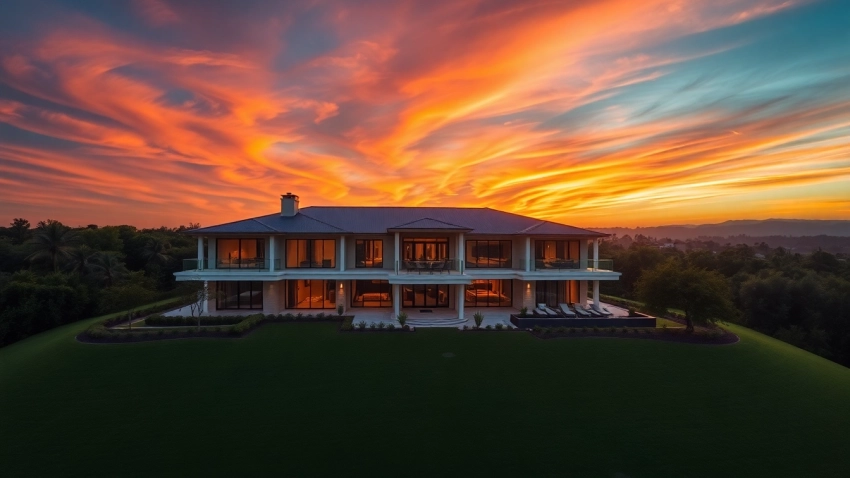
Exceptional Real Estate Aerial Photography That Highlights Property Value
In recent years, real estate has evolved tremendously, and so have the tools we use to showcase properties. One such transformative medium is real estate aerial photography. By harnessing the power of aerial imagery, real estate professionals can provide potential buyers with stunning perspectives and detailed overviews that ground-level photography cannot compete with. This article delves into the intricacies of aerial photography within the real estate domain, offering a comprehensive understanding of its benefits, techniques, equipment, planning requirements, editing practices, and marketing applications.
Understanding Real Estate Aerial Photography
What is Real Estate Aerial Photography?
Real estate aerial photography involves capturing images of properties from an elevated perspective, typically using drones or helicopters. This technique allows photographers to capture unique angles that highlight not only the property itself but also the surrounding landscape, neighborhood, and nearby amenities. Aerial photography can showcase the size of the property, the beauty of its surroundings, and any distinctive features that might make a property more appealing to potential buyers.
Benefits of Aerial Photography for Real Estate
The advantages of using aerial photography in real estate marketing are substantial. Here are some key benefits:
- Enhanced Visualization: Aerial shots offer a broader view, allowing potential buyers to see the entire property and its context within the neighborhood.
- Highlighting Features: Unique landscape features, such as swimming pools, gardens, and outdoor amenities, are more easily showcased from above.
- Increased Engagement: Properties with aerial images tend to attract more attention, increasing engagement rates on listings and social media posts.
- Competitive Advantage: Incorporating aerial imagery can differentiate a listing in a competitive market, making it stand out.
- Better Storytelling: Aerial views can help tell a story about a property’s location, surrounding amenities, and lifestyle opportunities.
Common Techniques Used in Aerial Photography
Aerial photography involves various techniques that can enhance the quality and effectiveness of the images taken. Some common techniques include:
- Bird’s Eye View: Capturing images directly overhead, providing a top-down perspective that showcases the layout of the property and surrounding area.
- Oblique Angle: Shooting at an angle, which helps to highlight vertical features, such as the height of a building, and can create a more dynamic composition.
- Panoramic Shots: Using stitching techniques to create wide-angle images that encompass more of the property and its surroundings.
- Focus Stacking: Combining multiple images taken at different focal lengths to maximize depth of field and ensure that every detail of the property is sharp.
Choosing the Right Equipment
Essential Gear for Aerial Photography
When it comes to real estate aerial photography, having the right gear is paramount for achieving high-quality images. The essential equipment includes:
- Camera: A DSLR or mirrorless camera with a high-resolution sensor allows for capturing detailed images with excellent dynamic range.
- Drone: A reliable drone equipped with a gimbal stabilizer can help eliminate vibrations during flight, ensuring clear and steady images.
- Lenses: Wide-angle lenses are ideal for capturing expansive views, while standard lenses can provide versatile shooting options.
- Filters: Polarizing filters can reduce glare and enhance colors, making the images more vibrant and appealing.
- Backup Batteries: Longer shoots may require additional batteries to ensure the drone remains operational throughout the session.
Camera Settings for Optimal Aerial Shots
To get the best results, understanding camera settings is crucial. Here are important settings to consider:
- ISO: Keep the ISO as low as possible to reduce noise, especially in bright conditions. An ISO of 100-400 is typically sufficient.
- Aperture: A setting between f/5.6 and f/11 will help achieve a good focus across the image while maintaining a sharp subject.
- Shutter Speed: A faster shutter speed (1/250 or higher) is advisable to avoid motion blur, particularly when capturing moving objects.
- Format: Shoot in RAW format for more flexibility in post-processing, allowing extensive adjustments without compromising image quality.
Drone Options for Real Estate Photography
With the surge in aerial photography, various drones are available in the market, each catering to different needs and budgets. Here are some popular options:
- Drones with 4K Cameras: Options like the DJI Mavic Air 2 offer excellent video quality and vibrant photos at an affordable price.
- Professional Drones: The DJI Phantom 4 Pro provides advanced features like obstacle sensing and live HD video feed, ideal for serious photographers.
- Compact Drones: For those needing portability without sacrificing too much quality, the DJI Mini 2 is lightweight and offers solid camera capabilities.
Planning Your Aerial Photography Shoot
Selecting Locations and Timing
Planning is crucial for successful aerial photography. Here are some tips for selecting locations and timing:
- Best Times of Day: The golden hour, shortly after sunrise or before sunset, provides soft lighting that enhances visual appeal.
- Seasonal Considerations: Different seasons can dramatically change the aesthetic of properties. Spring and summer may showcase lush greenery, while autumn offers vibrant falling leaves.
- Location Selection: Choosing properties located near parks, waterfronts, or other attractions can enhance the overall photo composition.
How to Prepare Properties for Aerial Photography
To ensure the best possible images, properties should be thoroughly prepared before the shoot. Here are some preparation steps to consider:
- Landscaping: Ensure lawns are mowed, gardens are tended, and any outdoor clutter is removed to present a tidy appearance.
- Clean the Property: Ensure windows are clean and any outdoor furniture is in order. A clean property will photograph better and create a more favorable impression.
- Access to Property: Ensure the pilot has clear access to the area and that any necessary permissions are obtained ahead of time.
Legal Considerations in Aerial Photography
Adhering to legal regulations is paramount in aerial photography. Here are critical considerations:
- Drone Regulations: Familiarize yourself with local laws regarding drone usage, including flight altitude restrictions and no-fly zones.
- Property Owner Permission: Always obtain permission from property owners before photographing their real estate to avoid legal disputes.
- Insurance: Consider drone insurance that covers any potential damage to property or third parties during a shoot.
Editing and Enhancing Aerial Images
Best Practices for Image Editing
Once the aerial images are taken, editing plays a crucial role in enhancing their appeal. Here are some best practices:
- Color Correction: Adjust the saturation and contrast to bring out colors without making them look overly artificial.
- Cropping: Utilize cropping to frame the image better and remove any distracting edges or elements.
- Sharpening: Apply slight sharpening to enhance details without making the image too harsh.
Using Software for Stunning Results
There are numerous software options available for editing aerial photography:
- Adobe Lightroom: Excellent for batch processing and offers advanced editing features suited for aerial imagery.
- Adobe Photoshop: Ideal for detailed enhancements, allowing detailed manipulation of image elements.
- Affinity Photo: A budget-friendly alternative to Photoshop, offering robust editing capabilities.
Additions and Overlays to Highlight Property Features
Utilizing overlays can enhance aerial images further. Here are some creative ideas:
- Property Boundaries: Overlay lines indicating property boundaries can add clarity for potential buyers.
- Text Annotations: Labeling features such as pools, gardens, and patios can help viewers quickly identify key selling points.
- Heat Maps: For larger properties, heat maps can identify foot traffic areas, helping buyers understand the most utilized spaces.
Marketing with Aerial Photography
Integrating Aerial Images into Listings
Once the aerial images are edited, it’s essential to leverage them effectively in marketing. Here are some integration strategies:
- Online Listings: Use high-quality aerial images in online listings to capture the attention of potential buyers immediately.
- Property Brochures: Include aerial shots in brochures and print materials for open houses and presentations.
- Virtual Tours: Incorporating aerial footage into virtual tours can provide buyers with a comprehensive view of both the property and its surroundings.
Leveraging Social Media for Aerial Photography
Social media platforms are powerful tools for showcasing aerial photography:
- Instagram: Use visually appealing aerial images to create a stunning portfolio. Utilize relevant hashtags to reach a broader audience.
- Facebook: Share images in community groups, real estate pages, or forums to engage local buyers.
- LinkedIn: If you’re a real estate professional, posting aerial photos can help position you as an authority in the market.
Analyzing the Impact of Aerial Photography on Sales
It’s essential to measure the effectiveness of aerial photography in driving sales. Here are key metrics to consider:
- Engagement Rate: Track likes, shares, and comments on property listings featuring aerial images.
- Lead Generation: Monitor how many inquiries arise from listings using aerial photography compared to those that don’t.
- Time on Market: Analyze whether properties with aerial photography sell faster than those without.












Leave a Reply